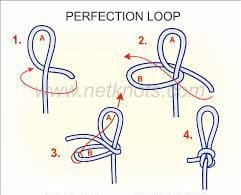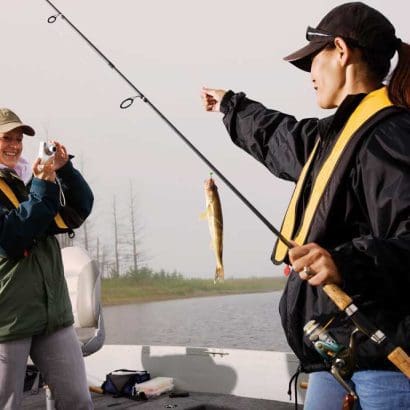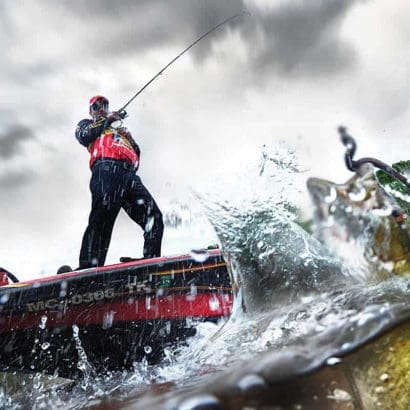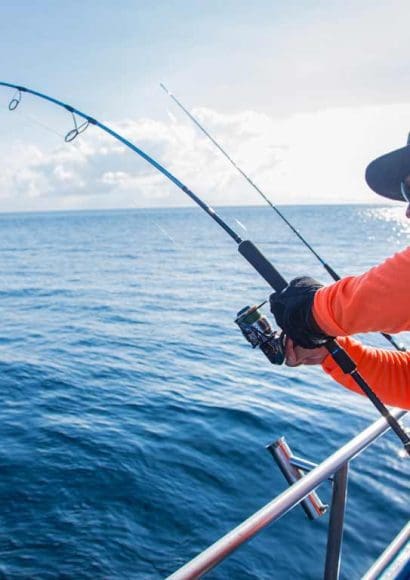
Fishing can be so much fun, right? But do you know one of the super important things you need to learn? It’s all about tying knots! Just like when you tie your shoelaces to keep your shoes from falling off, fishermen tie knots to keep their fishing lines from letting go of the big, wiggly fish they want to catch.
Today, we’re going to talk about fishing knots. These are special knots that are super strong, like superhero knots! Imagine you’re a superhero trying to catch a big fish, and these knots are your trusty sidekicks. We’ll show you how to tie the most useful and strong knots, so you can be a fishing superhero too!
Contents
The Basics of Fishing Knots.🐟
Hey there, young anglers! Welcome to the world of fishing knots, where you’ll become a knot-tying expert in no time. In this exciting journey, we’ll explore the fundamental building blocks of fishing knots, including why they’re super important, the basic concepts behind them, and how they relate to different types of fishing lines and hooks. By the end of this adventure, you’ll be ready to tackle any fishing challenge with your knot-tying skills!
Why Fishing Knots Are Essential
Okay, let’s get started with the big question: why are fishing knots so crucial in the fishing game? Imagine you’re playing catch with a friend, but your ball keeps slipping through your fingers. Frustrating, right? Well, that’s kind of like what happens when you don’t have strong knots in fishing.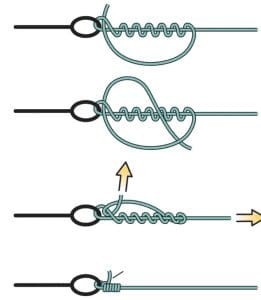
Fishing knots are like magical bonds that hold everything together. They keep your fishing line attached to your hook, lure, or bait, ensuring that when you reel in a fish, it won’t slip away. Think of it as a superhero’s cape that never lets them down. So, if you want to follow the fishing regulations and reel in some amazing catches, mastering these knots is a must!
Getting Familiar with Knot Basics
Now, let’s dive into the basic stuff. When it comes to fishing knots, there are two super important concepts to understand: resistance and safety.
- Resistance: This means how strong your knot is. Just like a super-strong superhero, your knot needs to be tough enough to handle the biggest, wiggliest fish in the water. The stronger the knot, the better your chances of landing a trophy fish!
- Safety: Safety is all about making sure your knot doesn’t let you down. A secure knot keeps your line connected to your hook, so you won’t lose any fish. It’s like having a safety net while walking on a tightrope – it keeps you from falling!
Different Types of Fishing Lines and Hooks
Now, let’s talk about the tools of the trade. There are different types of fishing lines and hooks out there, and the knots you use depend on what you’re fishing for and where you’re fishing.
- Fishing Lines: Fishing lines can be thin like spider silk or thick like a sturdy rope. They come in various materials, like monofilament, fluorocarbon, and braided lines. Each type has its strengths, and your choice affects which knot you should use.
- Hooks: Fishing hooks come in all shapes and sizes, from tiny ones for small fish to big ones for monsters of the deep. They have different eye shapes, and the right knot ensures your hook stays put, no matter how big the fish is!
Essential Fishing Knots.
Hey there, young anglers! It’s time to dive deeper into the world of fishing knots and explore the essential knots that every fisherman should know. In this exciting adventure, we’ll introduce you to some super-useful knots, including the nudo simple, the nudo de bucle, and the nudo de cirujano. Plus, we’ll give you step-by-step instructions on how to tie them and share some cool tips to help you choose the right knot for different fishing situations. So, grab your fishing gear, and let’s get knot-tying!
Discovering Common and Essential Knots
Before we jump into the knot-tying action, let’s get to know our knots better:
- The Simple Knot (Nudo Simple): This knot is like your fishing buddy’s handshake – simple and strong. It’s perfect for securing hooks, swivels, and lures to your fishing line. Just follow our step-by-step guide, and you’ll be a simple knot-tying expert in no time!
- The Loop Knot (Nudo de Bucle): Imagine making a tiny loop with your fishing line. The loop knot is excellent for allowing your bait to move freely, attracting curious fish. Learn how to tie this knot, and you’ll have an awesome trick up your sleeve for more bites!

- The Surgeon’s Knot (Nudo de Cirujano): Think of this knot as the magic glue that joins two pieces of fishing line together. It’s perfect for extending your line or attaching a leader. We’ll show you the secret recipe for this knot that every angler should know.
Step-by-Step Knot Tying
Now, let’s get practical and tie these knots step by step. Grab your fishing line, and let’s go:
Simple Knot (Nudo Simple)
Step 1: Thread the end of your line through the eye of the hook or lure. Step 2: Make a loop with the free end of the line. Step 3: Pass the loop over the hook or lure. Step 4: Thread the free end of the line through the loop. Step 5: Moisten the knot (that’s right, a little spit works wonders!) and pull both ends tight.
Loop Knot (Nudo de Bucle)
Step 1: Create a small loop in your line near the end. Step 2: Thread the tag end (the free end) through the eye of the hook. Step 3: Make sure the tag end wraps around the standing line, forming a loop. Step 4: Pass the tag end through the loop you created near the hook. Step 5: Moisten the knot and pull it tight.
Surgeon’s Knot (Nudo de Cirujano)
Step 1: Overlap the ends of the two lines you want to join. Step 2: Tie an overhand knot with the two lines, creating a loop. Step 3: Pass both ends through the loop twice. Step 4: Moisten the knot and pull both ends tight.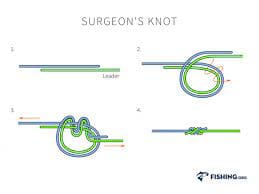
Choosing the Right Knot
Now, you might be wondering, “When do I use these knots?” Great question! Here’s a tip: the nudo simple is perfect for attaching hooks, the nudo de bucle for lures that need some wiggle room, and the nudo de cirujano for joining different lines together, like when you’re adding a leader.
Advanced Fishing Knots for Special Situations.🐟
Welcome back, young anglers! In our fishing knot adventure, we’re diving into the world of advanced knots, where you’ll learn about some super cool knots like the Palomar knot, the Rapala knot, and the Albright knot. These knots are like secret tools in a fisherman’s toolkit, and they can make a big difference when you’re out on the water. We’ll not only introduce you to these advanced knots but also show you when and how to use them in specific fishing situations. So, let’s get started on this exciting journey!
Exploring Advanced Knots
First, let’s meet our knot superheroes:
- The Palomar Knot: Think of the Palomar knot as the king of knots for hooks. It’s super strong and easy to tie. This knot is like having a superpower that makes sure your hooks stay put, no matter how feisty the fish is.
- The Rapala Knot: If you’re into lure fishing, the Rapala knot is your go-to sidekick. It’s designed to give your lures the freedom to move in the water, making them look more natural. Get ready to reel in some big ones with this knot!
- The Albright Knot: When you’re heading for saltwater adventures, the Albright knot is your trusty companion. It’s perfect for joining different types of lines together, ensuring your gear stays strong and ready for action.
When and How to Use These Knots
Now, let’s talk about when and how to unleash the power of these advanced knots:
- Palomar Knot: Use this knot when you want to attach hooks to your line. It’s great for all sorts of fishing, from freshwater to saltwater. Follow our step-by-step guide to tie it like a pro!
- Rapala Knot: Whenever you’re using lures that need to wiggle freely, like crankbaits or minnows, the Rapala knot is your secret weapon. We’ll show you how to tie it to give your lures maximum movement.
- Albright Knot: Planning a saltwater fishing trip? The Albright knot is your go-to choice for joining different lines. It’s like the glue that keeps everything together. Follow our steps to conquer this knot with ease.
Step-by-Step Knot Tying🐟
Let’s not keep these knots a secret any longer. Here’s how to tie them step by step:
Palomar Knot
-
- Double your line and pass it through the eye of the hook.
- Tie a simple knot with the doubled line, creating a loop.
- Pass the loop over the hook.
- Pull the loop and both ends of the line tight. Trim the excess.
Rapala Knot
-
- Thread the end of your line through the lure’s eye.
- Bring the end back and tie an overhand knot around the standing line.
- Pass the lure through the loop created by the overhand knot.
- Moisten the knot and pull it tight.

Albright Knot
-
- Overlap the two lines you want to join.
- Wrap the tag end of one line around the other line multiple times.
- Thread the tag end back through the loop created.
- Moisten the knot and pull both lines tight.
Strengthening Your Knots.🐟
Hey there, young anglers! In our fishing knot journey, we’ve learned some amazing knots, but what’s equally important is making sure those knots are super strong. We’ve got your back with some practical tips to increase the resistance of your knots. We’ll share advice like wetting the line before tying knots, avoiding common mistakes that weaken knots, and how to keep your knots in top-notch shape during your fishing adventure. Let’s dive in and make your knots tougher than ever!
Practical Tips for Stronger Knots
We all know that strong knots are the key to keeping those fish on your line. Here are some simple yet powerful tips to boost the strength of your knots:
- Wet Your Line: Before tying any knot, it’s a great idea to wet the line with a little water. This makes the line more flexible and less likely to weaken or break during the knot-tying process. Think of it as giving your knot a refreshing drink to keep it strong.
- Check for Twists and Tangles: Sometimes, your line can get twisted or tangled, and that’s a no-no for strong knots. Always inspect your line for any irregularities before tying your knot. A smooth, untangled line is your knot’s best friend.
- Tight and Right: When tying your knots, make sure they’re snug and tight. You want your knot to hold onto that fish with all its might. Take your time and pull both ends of the line to secure the knot properly.
Avoiding Common Knot-Weakening Mistakes
Now, let’s talk about some mistakes that can weaken your knots. Avoiding these blunders is like protecting your knot’s secret superpowers:
- Knot Overlap: Don’t let your knots overlap each other on the same line. This can create weak points. Keep your knots separate and give them space to work their magic.
- Using Old Line: Fishing line can wear out over time, making it more prone to breaking. If your line looks worn or frayed, it’s time to replace it. Fresh line equals stronger knots.
- Improper Cinching: Cinching is the final step in knot-tying, and it’s crucial to get it right. Make sure you pull both ends of the line evenly to ensure the knot tightens properly. A half-hearted cinch can lead to a weak knot.
Maintaining Your Knots During Fishing
Lastly, let’s talk about keeping your knots in top shape while you’re out on the water:
Regular Checks: It’s a good practice to inspect your knots from time to time while fishing. Look for any signs of wear, damage, or slippage. If you spot any issues, re-tie the knot to keep it strong.
Trim Excess Line: After tying your knot, trim any excess line to prevent it from getting tangled or caught on something. A clean knot is a strong knot.
Mastering Your Fishing Knots Through Practice🐟
Hello, young anglers! In our journey through the world of fishing knots, we’ve learned some fantastic knot-tying techniques. But here’s the secret sauce: practice. In this section, we’ll explore why practice is essential, suggest some fun knot-training exercises, and teach you how to inspect and fortify your knots before you hit the water. Let’s perfect those knots and become true masters of the craft!
The Significance of Practice
Think of practice as your secret weapon in the world of fishing. Here’s why it matters:
- Boosts Confidence: The more you practice, the more confident you become in your knot-tying skills. Confidence is key when you’re out there trying to catch the big one.
- Speed and Efficiency: With practice, you’ll tie knots faster and more efficiently. Imagine being able to re-tie a lure quickly, giving you more time to fish.
- Consistency is King: Consistency in knot tying is crucial. Practicing ensures that you tie your knots the same way every time, making them stronger and more reliable.
Knot Training Exercises
Let’s have some knot-tying fun with these exercises:
The Blindfold Challenge: Try tying your favorite knot blindfolded. This exercise sharpens your muscle memory, making it easier to tie knots in tricky situations on the water.
Speed Knot Tying: Set a timer and see how quickly you can tie a specific knot correctly. Challenge yourself to beat your own time with each attempt.
Knot Swap: Practice tying different knots repeatedly to become versatile. You never know which knot will be your secret weapon for the day.
Inspecting and Reinforcing Your Knots
Before you head out for a fishing trip, it’s essential to inspect and reinforce your knots. Here’s how:
Visual Inspection: Examine your knots closely for any signs of damage, such as frayed or worn areas. If you see any issues, it’s best to re-tie the knot.
Tug Test: Give your knots a gentle tug to ensure they’re secure. If a knot slips or feels loose, it’s a sign that it needs to be redone.
Knot Lubrication: A bit of saliva or water on your knots can reduce friction and make them more secure. Think of it as giving your knots a little boost of strength.

